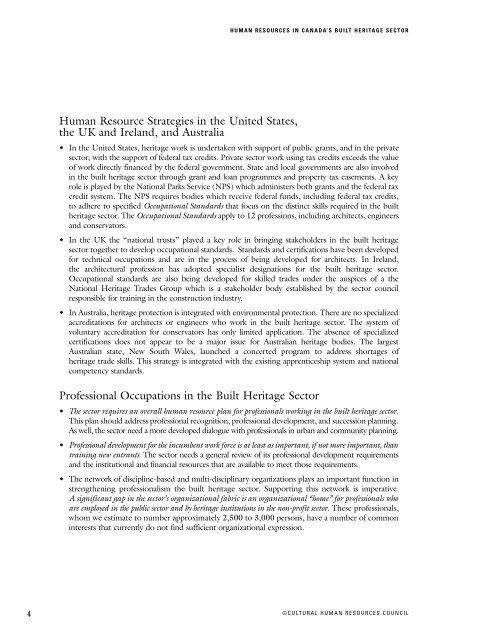Human Resources in Canada's Built Heritage Sector: Mapping the ...
Human Resources in Canada's Built Heritage Sector: Mapping the ...
Human Resources in Canada's Built Heritage Sector: Mapping the ...
- No tags were found...
Create successful ePaper yourself
Turn your PDF publications into a flip-book with our unique Google optimized e-Paper software.
HUMAN RESOURCES IN CANADA’S BUILT HERITAGE SECTOR<strong>Human</strong> Resource Strategies <strong>in</strong> <strong>the</strong> United States,<strong>the</strong> UK and Ireland, and Australia• In <strong>the</strong> United States, heritage work is undertaken with support of public grants, and <strong>in</strong> <strong>the</strong> privatesector, with <strong>the</strong> support of federal tax credits. Private sector work us<strong>in</strong>g tax credits exceeds <strong>the</strong> valueof work directly f<strong>in</strong>anced by <strong>the</strong> federal government. State and local governments are also <strong>in</strong>volved<strong>in</strong> <strong>the</strong> built heritage sector through grant and loan programmes and property tax easements. A keyrole is played by <strong>the</strong> National Parks Service (NPS) which adm<strong>in</strong>isters both grants and <strong>the</strong> federal taxcredit system. The NPS requires bodies which receive federal funds, <strong>in</strong>clud<strong>in</strong>g federal tax credits,to adhere to specified Occupational Standards that focus on <strong>the</strong> dist<strong>in</strong>ct skills required <strong>in</strong> <strong>the</strong> buil<strong>the</strong>ritage sector. The Occupational Standards apply to 12 professions, <strong>in</strong>clud<strong>in</strong>g architects, eng<strong>in</strong>eersand conservators.• In <strong>the</strong> UK <strong>the</strong> “national trusts” played a key role <strong>in</strong> br<strong>in</strong>g<strong>in</strong>g stakeholders <strong>in</strong> <strong>the</strong> built heritagesector toge<strong>the</strong>r to develop occupational standards. Standards and certifications have been developedfor technical occupations and are <strong>in</strong> <strong>the</strong> process of be<strong>in</strong>g developed for architects. In Ireland,<strong>the</strong> architectural profession has adopted specialist designations for <strong>the</strong> built heritage sector.Occupational standards are also be<strong>in</strong>g developed for skilled trades under <strong>the</strong> auspices of a <strong>the</strong>National <strong>Heritage</strong> Trades Group which is a stakeholder body established by <strong>the</strong> sector councilresponsible for tra<strong>in</strong><strong>in</strong>g <strong>in</strong> <strong>the</strong> construction <strong>in</strong>dustry.• In Australia, heritage protection is <strong>in</strong>tegrated with environmental protection. There are no specializedaccreditations for architects or eng<strong>in</strong>eers who work <strong>in</strong> <strong>the</strong> built heritage sector. The system ofvoluntary accreditation for conservators has only limited application. The absence of specializedcertifications does not appear to be a major issue for Australian heritage bodies. The largestAustralian state, New South Wales, launched a concerted program to address shortages ofheritage trade skills. This strategy is <strong>in</strong>tegrated with <strong>the</strong> exist<strong>in</strong>g apprenticeship system and nationalcompetency standards.Professional Occupations <strong>in</strong> <strong>the</strong> <strong>Built</strong> <strong>Heritage</strong> <strong>Sector</strong>• The sector requires an overall human resource plan for professionals work<strong>in</strong>g <strong>in</strong> <strong>the</strong> built heritage sector.This plan should address professional recognition, professional development, and succession plann<strong>in</strong>g.As well, <strong>the</strong> sector need a more developed dialogue with professionals <strong>in</strong> urban and community plann<strong>in</strong>g.• Professional development for <strong>the</strong> <strong>in</strong>cumbent work force is at least as important, if not more important, thantra<strong>in</strong><strong>in</strong>g new entrants. The sector needs a general review of its professional development requirementsand <strong>the</strong> <strong>in</strong>stitutional and f<strong>in</strong>ancial resources that are available to meet those requirements.• The network of discipl<strong>in</strong>e-based and multi-discipl<strong>in</strong>ary organizations plays an important function <strong>in</strong>streng<strong>the</strong>n<strong>in</strong>g professionalism <strong>the</strong> built heritage sector. Support<strong>in</strong>g this network is imperative.A significant gap <strong>in</strong> <strong>the</strong> sector’s organizational fabric is an organizational “home” for professionals whoare employed <strong>in</strong> <strong>the</strong> public sector and by heritage <strong>in</strong>stitutions <strong>in</strong> <strong>the</strong> non-profit sector. These professionals,whom we estimate to number approximately 2,500 to 3,000 persons, have a number of common<strong>in</strong>terests that currently do not f<strong>in</strong>d sufficient organizational expression.4©CULTURAL HUMAN RESOURCES COUNCIL










